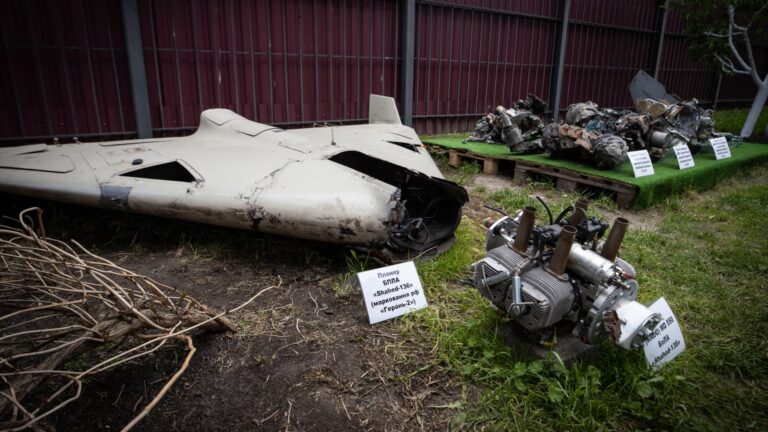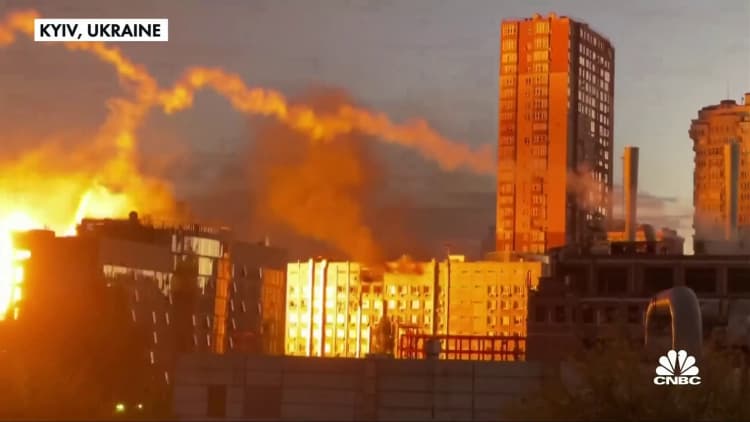
[ad_1]
Remain of Shahed 136 at an exhibition showing remains of missiles and drones that Russia used to attack Kyiv on May 12, 2023 in Kyiv, Ukraine.
Oleksii Samsonov | Getty Images
Iran is seeing new demand for its drones, a development that has drawn concern from Washington and renewed Tehran’s focus on deepening its alliances in South America.
Bolivia’s defense minister last week confirmed his country’s interest in acquiring Iranian drones, days after he visited Tehran for a bilateral meeting on July 20 to sign what he said was an “act” on areas of common interest. Iranian state news outlets IRNA and Fars reported that the two countries signed a memorandum of understanding on defense and security.
related investing news

“Latin American countries are of special significance in Iran’s foreign and defense policy based on the importance of [the] very sensitive South American region,” Iran’s defense minister, Mohammad Reza Ashtiani, was quoted as saying.
After Bolivian opposition party members and neighboring Argentina’s Foreign Ministry demanded information on the reported memorandum, Bolivia’s defense minister, Edmundo Novillo, said his government was indeed interested in advanced Iranian drones.
Novillo said they would be used to protect the country’s borders from drug trafficking and smuggling, and could help monitor mountainous areas and improve military surveillance. “Their technology could satisfy the requirement that we have raised,” he said, according to reports, without specifying what kind of drones his government wanted.
The minister dismissed critics’ concerns, saying: “It is not a threat, nor could we lend ourselves to some type of actions that could generate attacks or something like that. We are pacifists.” He also denied that Bolivia and Iran signed a formal memorandum. CNBC has reached out to both Iran’s and Bolivia’s Foreign Ministries for comment.
A ‘considerable’ battlefield impact
In 2022, Iran had the largest arsenal of missiles and drones in the Middle East, according to the U.S. Defense Intelligence Agency. Iran’s drones have made “considerable impact on any battlefield they have appeared in,” according to Farzin Nadimi, an arms expert at The Washington Institute.
Despite production and trade challenges due to heavy Western sanctions, the performance of Iranian drones is “at par with the competition, and in some respects, even better” — while also being cheaper, Nadimi said in a report by the U.S. Institute of Peace.
“By the fall of 2022, Tehran had also exported drones or drone technology to at least five countries on four continents as well as to at least seven proxy militias in the Middle East,” the report read.
U.S. concerns center on Iran’s deepening foreign alliances and dissemination of its lethal drones, analysts say.
Two days after Novillo’s remarks, John Kirby, spokesman for the U.S. National Security Council, said in an interview that the Biden administration is “concerned about any export of Iranian technology that can be destabilizing.”
Iran presents its first hypersonic ballistic missile ‘Fattah’ (Conqueror) in an event attended by President Ebrahim Raisi and other government officials in Tehran, Iran on June 06, 2023.
Sepah News | Anadolu Agency | Getty Images
Kirby noted the U.S. sanctions already in place against Iran for its export of lethal drones to Russia, adding, “We urge all nations, no matter where they are, to carefully consider before they enter into defense arrangements with a nation like Iran.”
Previously only supplying drones to a few Middle Eastern allies, Iran is now expanding its reach after using Ukraine as a testing ground and launchpad to becoming a global provider of lethal drone technology. Its long-range Shahed-136 drones in particular have been used by Russia to devastating effect on Ukraine’s cities and critical infrastructure.
Customers in Europe, Africa, Latin America, Asia
An apparent marketing push to countries in the developing world has strengthened Iran’s alliances, while also improving revenue streams — something of critical importance to Tehran after several years of economic decimation under U.S. sanctions.
“Iran is always looking to showcase its diversified ties. This helps Iran push back against maximum pressure sanctions and show that despite all U.S. efforts at containment, Iran has broadened the resistance axis and is able to be a destabilizing actor in America’s backyard,” Sanam Vakil, director of the Middle East and North Africa program at Chatham House, told CNBC.
Many Latin American countries cooperate with Iran as part of a broader opposition to the U.S., or because they are under U.S. sanctions – in particular Venezuela, which has been receiving Iranian drone technology since 2007. On a recent visit to Latin America, Iranian President Ebrahim Raisi stressed the importance of an alliance between Iran, Cuba, Nicaragua, and Venezuela in a common struggle against “imperialism and domination” by the U.S. and the West.
Since the socialist party returned to power in Bolivia in 2020, the country has made a concerted effort to revive ties with Venezuela and Iran.

Still, “greater economic cooperation with Latin American countries will not enable the Iranian regime to fix the structural flaws in Iran’s economy,” the U.S. Institute of Peace wrote, pointing to issues of corruption and Revolutionary Guard Corps control over the economy as matters needing the most focus.
Other regional analysts described Raisi’s tour of Latin America as politically symbolic but not economically tangible.
Washington-based think tank the Institute for the Study of War wrote on July 20 that Iran had sought to increase the number of countries that buy its drones. It added that a former Revolutionary Guard Corps commander, “boasted in October 2022 that 22 countries — including Algeria, Armenia, Serbia, Tajikistan, and Venezuela — had submitted formal requests for Iranian drones.”
Additionally, Raisi “promoted Iranian drone technology during several recent foreign trips, including during his most recent trip to Kenya, Uganda, and Zimbabwe between July 12-14,” the ISW wrote. Iran has previously provided drones to African countries including Sudan and Ethiopia, which the latter used against Tigray rebels.
‘Axis of resistance’
Israel has also been closely watching Iran’s drone industry, with Defense Minister Yoav Gallant saying in February that Iran at the time was “holding discussions to sell advanced weapons, including UAVs and PGMs (precision-guided missiles), to no less than 50 different countries.”
“Iran is no longer a ‘local supplier’ serving proxies in the Middle East. It is a ‘multinational corporation,’ a global exporter of advanced weapons,” Gallant said. “From Belarus in Eastern Europe, to Venezuela in South America, we have seen Iran delivering UAVs with a range of up to 1,000 kilometers.”
Missiles of the kind used during Iran’s retaliatory strike on the U.S Ayn al-Asad military base in 2020 are seen on display at Imam Khomeini Grand Mosalla in Tehran, Iran January 7, 2022.
Majid Asgaripour | WANA | via REUTERS
The building of factories to produce Iranian drones in other countries allied with Iran has also picked up pace – Tajikistan, Venezuela, and Syria reportedly have such facilities, with another planned in Russia.
For Iran, the local drone and weapons industry is not only a valuable source of revenue, but a means of building what Raisi calls an “axis of resistance” against the U.S. and West. That attempt to overturn the current world order was praised last October by former Revolutionary Guard Commander Maj. Gen. Yahya Rahim Safavi.
“A new era has begun,” Safavi declared at the time. “We are now witnessing great changes in new technology, wealth, power and global order.”
[ad_2]
